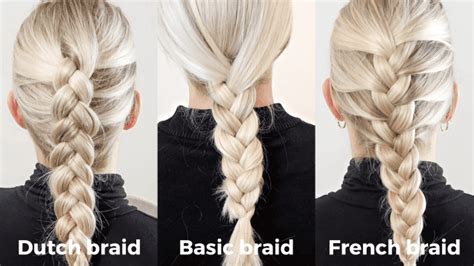Introduction
Braids are a versatile and timeless hairstyle that can be worn by people of all ages and hair types. There are countless different types of braids, but two of the most popular are the Dutch braid and the French braid. Both braids are beautiful and can be styled in a variety of ways, but there are some key differences between the two.

Dutch Braid vs French Braid: What’s the Difference?
The main difference between a Dutch braid and a French braid is the way the hair is sectioned and crossed over. In a Dutch braid, the hair is crossed over underneath instead of on top, which creates a raised, textured effect. French braids, on the other hand, are crossed over on top, which creates a flatter, more intricate look.
Which Braid is Right for You?
The best braid for you depends on your personal preferences and the occasion. Dutch braids are a good choice for people who want a dramatic, eye-catching style. They are also a good choice for people with thick, unruly hair, as the tight weaving can help to tame frizz and flyaways. French braids, on the other hand, are a good choice for people who want a more elegant, sophisticated look. They are also a good choice for people with fine, thin hair, as the looser weaving can help to add volume and body.
How to Braid a Dutch Braid
- Start by brushing your hair to remove any tangles.
- Divide your hair into three equal sections.
- Cross the right section over the middle section.
- Cross the left section over the new middle section.
- Take a small section of hair from the right side and add it to the right section.
- Cross the right section over the middle section.
- Take a small section of hair from the left side and add it to the left section.
- Cross the left section over the new middle section.
- Repeat steps 5-8 until you reach the end of your hair.
- Secure the braid with a hair tie.
How to Braid a French Braid
- Start by brushing your hair to remove any tangles.
- Divide your hair into three equal sections.
- Cross the right section over the middle section.
- Cross the left section over the new middle section.
- Take a small section of hair from the right side and add it to the right section.
- Cross the right section over the new middle section.
- Take a small section of hair from the left side and add it to the left section.
- Cross the left section over the new middle section.
- Repeat steps 5-8 until you reach the nape of your neck.
- From here, continue braiding the hair as you would a regular three-strand braid.
- Secure the braid with a hair tie.
Common Mistakes to Avoid
- Not sectioning your hair evenly. This can make your braid uneven and messy.
- Crossing the hair too tightly. This can make your braid uncomfortable and cause it to pull on your hair.
- Not adding hair from the sides. This can make your braid thin and limp.
- Not securing the braid properly. This can cause your braid to come undone.
Conclusion
Dutch braids and French braids are both beautiful and versatile hairstyles that can be worn by people of all ages and hair types. The best braid for you depends on your personal preferences and the occasion. If you want a dramatic, eye-catching style, a Dutch braid is a good choice. If you want a more elegant, sophisticated look, a French braid is a good choice. With a little practice, you can master both of these braids and create a variety of beautiful hairstyles.
